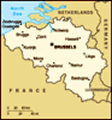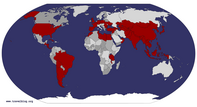Advertisement
Published: October 23rd 2014
We left the UK behind on a fairly smooth sailing from Dover to Dunkirk. Trish was more than happy to get off at the other side though, and we then faced an hour or so's drive down to Ypres. We took a wrong turn, and then another, and by the time we reached our destination it was dark. That made finding our B&B a little difficult as it wasn't easy to find the right road out of Ypres and then it wasn't easy to spot the sign set back at the side of the road. When we finally got to
La Passarelle, we were made very welcome by our hosts, Marc and Sonja. They provided us with a welcome beer and a nice chat before we decided on an early night anticipating a very full day ahead of us.
Ypres and the surrounding area played a major part in the First World War. Whenever you hear phrases like "The Western Front", many of the stories will emanate from this region. Our first stop was just down the road from our digs.
Hooge Crater is not so-called because there is a huge crater there. Yes, there is a crater and it is located
in what was the village of Hooge. The
Commonwealth War Grave Cemetery is beautifully kept, as they all are, and we saw some maintenance in action which shows how lovingly they are tended. More or less opposite the cemetery there is a small museum but it hadn't yet opened as we passed by. Instead we walked a couple of hundred yards up the road to the site of the crater itself. There we had the chance to walk through some trenches which gave an eerie sense of how awful life must have been in them. We also visited a mosquito ridden bunker! Large piles of ammunition litter the woods and the crater is now filled with water showing just how big it is. The crater is not the result of aerial bombardment. It was actually caused by British troops tunneling underneath German positions and blowing them up.
Our next stop was the area around Polygon Wood. First of all we paid a visit to the Black Watch memorial which shows a kilted soldier on a plinth. Nearby fields are filled with poppies. On the other side of the woods we visited
Polygon Wood Cemetery. There are not many graves there and they are laid
out in a haphazard way. The information plaques tell the story that soldiers were buried where they fell resulting in the rather unusual layout. Just over the road and along a track back into the woods is the
Buttes new British Cemetery which houses many, many antipodean graves.
From there we made our way to Zonnebeke, home of the
Passchendale Memorial Museum and research centre. The grounds of the museum are extensive but wandering around is important in order to reflect on the horrors that occurred here one hundred years ago. In the tranquil woods it is hard to imagine what went on. There are some memorial gardens, one for each major nation involved in the war, which when seen from above are in the shape and colour of a poppy. From the ground you can't see it though, so it's a shame there isn't an aerial platform you could climb to get that bird's eye view. On the edge of the wood is Zonnebeke Cathedral which was destroyed in the war. The modern day version is wonderful inside and certainly worth a few moments of contemplation.
Just outside Zonnebeke is
Dochy Farm Cemetery. This cemetery is of particular interest to football fans. One of
the nearly 1500 graves is that of Sergeant James Speirs. This fallen hero's grave contains tributes from Glasgow Rangers football club. His biggest moment of fame came in the 1911 FA Cup final after his move to Bradford City in England. James scored the only goal as the Bantams beat Newcastle United 1-0 at Wembley to hoist the famous trophy. He went on to break goalscoring records for Leeds United before the outbreak of war. Further details can be found in the cemetery book just inside the entrance.
Not far away is the enormous
Tyne Cot Cemetery and visitors' centre. This is the biggest Commonwealth cemetery and contains almost 15,000 graves. That is a staggering loss of life, but the memorial inside the cemetery is inscribed with a further 35,000 names. This is the place you go to in order to begin to conceive the sheer numbers of people that died in this war. The graves and inscriptions make 50,000 but that is nothing compared to the total number who lost their lives in this conflict. The visitors' centre has lots of information about the local area and there are interactive displays enabling you to research any fallen heroes in your family.
The most moving part is the continual reading out of names from the list of graves which haunts the centre and its immediate surroundings.
There are so many more cemeteries and memorials in the area that it would be a physical impossibility to visit them all. After a while the horror becomes too much and you need a break. We drove into the centre of Ypres and were lucky to find a parking space. It is a beautiful city in its own right and provided just the kind of "normality" we were seeking in
Paul's Boutique Burgers . Now Belgium is not a cheap place to eat out by any means but Paul's prices were quite reasonable and his burgers were fabulous.
After lunch it was back to the war. "
In Flanders Fields" Museum is located in the grandest building in the centre of Ypres. For €9 were were given a poppy bracelet which opens up some interactive displays and allows you to change the language on some things. The museum tells the story of how this region survived World War I. There are first hand accounts, haunting videos of actors portraying soldiers on both sides, countless artifacts and many, many more
educational displays in this hi-tech interactive history lesson. For some it may be a little too hi-tech. For others it may prove a bit too graphic and emotional. For us the problem was the volume of people inside. It was impossible to use our wristbands because there were so many others trying to do the same. Nonetheless it is a worthwhile museum to visit. We think we did it the right way round by travelling around the area first then getting more context in the museum. You will leave in silence as you begin to contemplate what went on here.
In the evening our destination was the
Menin Gate at the eastern end of the city centre. Get there before 7.30pm or you will be at the back of a very large crowd. Every evening people gather there to hear a troop of buglers play The Last Post at 8pm. It is incredibly moving to stand in the middle of a memorial inscribed with 54,000 names and hear that tune. Silence is the order of the day and it is no place for a screaming baby. Why, oh why, would anyone take their infant child to such a place knowing
that, in all likelihood, they will be the ones to destroy the silence everyone else craves. We were also treated to a choir singing in tribute. Normally only one outside group per night takes part in the ceremony. That night the Kernow Pipe and Drum Band were visiting from Cornwall and, pushing tradition aside (and rightly so), they were also invited to take part. Seeing and hearing a piper lead his colleagues through the memorial was a very special thing. Later the band played a few tunes to a small crowd in the city square which was a nice tribute.
It was a lot to fit in to one day in Belgium but we are so pleased that we did it. The centenary commemorations mean there are lots of events taking place in the coming years so we would highly recommend a visit to the region for anyone who is remotely interested in this dreadful part of Europe's history.
Advertisement
Tot: 0.106s; Tpl: 0.015s; cc: 20; qc: 32; dbt: 0.043s; 1; m:domysql w:travelblog (10.17.0.13); sld: 1;
; mem: 1.2mb



























D MJ Binkley
Dave and Merry Jo Binkley
Belgium
Fascinating photo